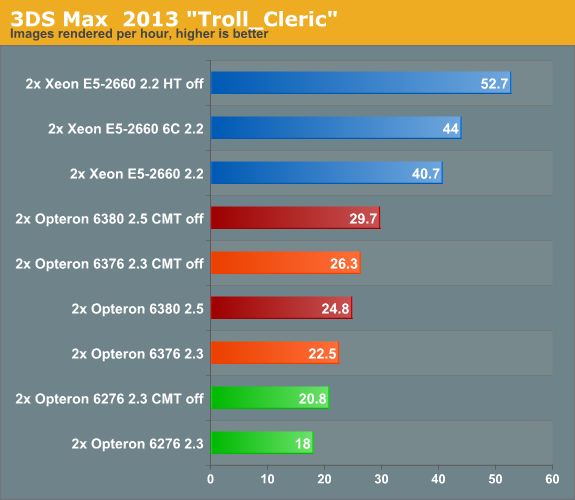The new Opteron 6300: Finally Tested!
by Johan De Gelas on February 20, 2013 12:03 AM EST3DS MAX 2013
Our previous benchmark, the "architecture" scene that is included in the SPEC APC 3DS Max 2007 test, was getting way too old. So we decided to switch to the "Trol_cleric29_max2010" scene while upgrading to 3DS MAX 2013. We render at 1080p (1920x1080) resolution and measure the time it takes to render the first three frames (from 0 to 2). The 64-bit version of 3DS Max 2013 runs on top of 64-bit Windows 2008 R2 SP1. All results are reported as rendered images per hour; higher is thus better.


The results are pretty chaotic at first sight. But the numbers are correct and can be verified by a third party or by yourself for that matter. Let us try to make sense out of this.
First of all, we used the NIVDIA Mental Ray renderer, which despite the "NVIDIA" part in its name is still a CPU only renderer. Secondly, the new benchmark is better than the old one: most of the time all cores are working at very high CPU load: typically 96% and more. However we noticed that without Hyper-Threading and CMT, the CPUs are able to turbo longer and at higher clockspeeds and there are small periods of single threaded action. These two facts together probably explain why disabling Hyper-Threading or CMT improves performance by 20% and more.
Cinebench reports that the Xeon 2660 is 20% faster than the Opteron 6380. In the 3DS Max, the Xeon is up to 77% faster. The new Mental Ray engine seems to be extremely well optimized for the Intel architectures and underperforms on the AMD architecture.
At the end of the day, it is clear that Intel has a huge advantage here, but also that this market is shifting more and more to GPU rendering. This is out of the scope of this article, but many people in the rendering business are using GPU accelerated rendering thanks to NVIDIA's iray renderer. CPU + GPU rendering with iRay seems to outperform Mental Ray in almost all scenes except those with relatively simple lighting, so combining an Intel E5 Xeon with a fast GPU is the best option.










55 Comments
View All Comments
sherlockwing - Wednesday, February 20, 2013 - link
These Piledriver based Opterons look competitive but the threat of Ivy-EP is immenient. The last time Intel die-shrunk their High end platform they introduced the monsterous 10 core Westmere-EP(the current Xeon E7 lineup), I wouldn't be surprised Ivy-EP introduces 10/12 core extreme E7 Xeons as well as Octa Xeons with better performance/watt.Kevin G - Wednesday, February 20, 2013 - link
Ivy Bridge-E is indeed coming but it is looking to be 6 months out. These Opterons were shipping since November which would give them a 10 month lead time. The real question for AMD is what they'll have in response in that time frame. Steamroller based parts all look to be released in 2014. On the bright side, AMD should be pairing those chips with a new socket as DDR4 becomes available.One thing though about Ivy Bridge-E is that it will also be a socket 2011 part so migration to it should get relatively quick in comparison to the Westmere-EP to Sandybridge-E transition. The same cost savings for OEM noted in this article for socket G32 Opterons will apply to Ivy Bridge-E this time around.
Oskars Apša - Wednesday, February 20, 2013 - link
Wasn't intels 2011 socket to be only physically identical, but electrically totally redesigned?Hrel - Friday, February 22, 2013 - link
"These Opterons were shipping since November"I reject this statement. Nothing counts as being "on the market" until Anandtech has done a full review of it. That's my stance and I'm sticking to it :P
Beenthere - Wednesday, February 20, 2013 - link
...is that the 63xx series is focused primarily on micro servers where it fits well. If the just disclosed Jaguar cores are any indication of AMD products to be released this and next year, I'd say AMD is back in the game in many PC and portable markets.The only thing Ivy Bridge has going for it is reduced power but at a price penalty.
JohanAnandtech - Thursday, February 21, 2013 - link
SeaMicro was indeed one of first to use Piledriver based cores, but I don't think the Opteron 6300 is meant to be a "typical" microserver CPU. Otherwise, AMD would have focused more on low power parts. This meant to be an update for the general server market.Jovec - Wednesday, February 20, 2013 - link
... as it is showing the multi-threaded chart instead.JohanAnandtech - Wednesday, February 20, 2013 - link
Fixed. Thanks for pointing it out, always appreciated.Death666Angel - Wednesday, February 20, 2013 - link
Hey!I get a " Page Not Found" error from the Racktivity PDU link. :)
ssj3gohan - Wednesday, February 20, 2013 - link
You say that AMDs bad implementation of C6 costs them in the energy efficiency tests, but AFAIK with a low of still 10% CPU the CPU should not enter ACPI C3 (Intel C6), it will probably stay in C1e providing there is still more than enough workload to do on each OS tick.If the xeons are observed to go into ACPI C3, then that is very probably a scheduler optimization specific for intel processors, not an actual implementation problem by AMD. Balancing C-state transitions - especially complete core sleep modes like ACPI C3 - is a notoriously hard task to do because each transition also costs a certain amount of mJ that, on immediate wake, are wasted compared to just leaving the cores in C1(e)